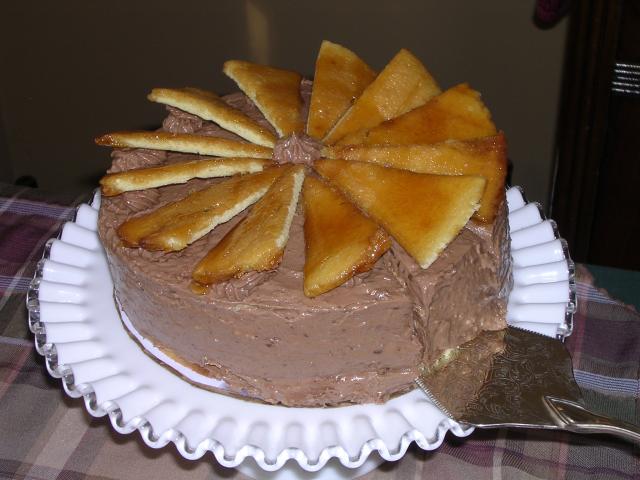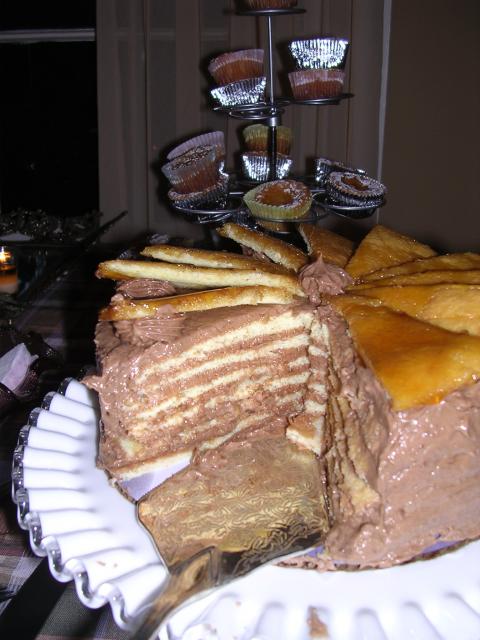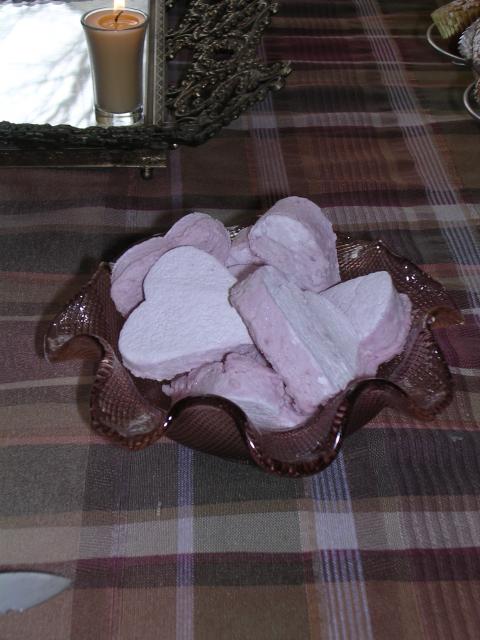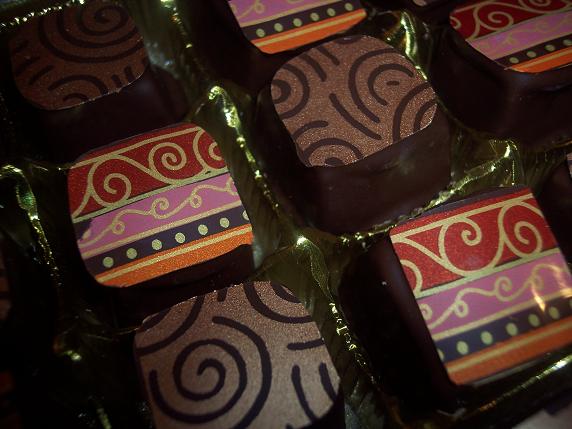-
Posts
703 -
Joined
-
Last visited
Content Type
Profiles
Forums
Store
Help Articles
Posts posted by RuthWells
-
-
Let me begin by stating that I am a novice at tempering chocolate....I have tried tempering chocolate several times over the past week with no success. I am using the microwave with the seeding method and I have also tried the cold bath method. I have an IR thermometer and am sure that I am getting the chocolate to the right high and low temperatures. I stir alot to ensure even temperature through out the bowl. I am using a glass bowl. The chocolate pops out of the mold easily, but melts to the touch and is a little mushy if you squeeze it between your fingers. Why?
I think that the problem may be due to one of the following issues:
1. The chocolate that I am using...It is Ghirardelli Semisweet 60%, but it says baking instead of coveature. Could this be the problem. I am beginning to think that maybe baking chocolate can not be tempered?
2. Maybe I can not recognize when the chocolate is in temper, from lack of experience. I mold the chocolate immediately, within seconds of when I think it is in temper. Maybe it's not in temper?
3. Maybe I am not allowing the molds to set long enough. I was trying heart shaped molds of solid chocolate. Approximate diameter of 1/2 inch. I would put them immediately into the refrigerator for 10-15 minutes. Maybe that is not long enough?
My kitchen temperature averages 68-70 degrees farenheit, there is no humidity...I can not figure this out.
Any suggestions and/or comments will be greatly appreciated. -Thanks
Hi, Indulge, and welcome to eGullet! You will get responses from folks far more experienced than I, but first off, the chocolate itself is not at fault. Ghiradelli 60% is in temper when you purchase it, and is retemperable. The only stuff that isn't really temperable is the "chocolate" candy wafers that are sold by craft stores such as Michaels and Hobby Lobby (Wilton is one brand).
With that said, the other immediate suggestion I have is, stop using your fridge to set the chocolate. As long as you have someplace to put the items at cool room temp, the chocolate will set as long as it has been properly tempered. Chocolate will set in the fridge whether it's been tempered or not, so you can easily be misled!
After you melt, seed, and stir your chocolate down to the target temp, do a test by smearing a swatch of chocolate onto a piece of parchment or waxed paper in a cool-ish room (not in the kitchen if you've been baking bread, in other words). It should start to set up pretty quickly, and within a few minutes the surface should no longer be wet and shiny, but should look matte and dull.
When you're seeding your melted chocolate, you should add no more than 1/3 or so of the weight of the melted chocolate in solid chocolate. As you stir, once in a while lift your spatula and let the melted chocolate pour back into the bowl. Observe how the poured chocolate re-incorporates itself with the mass of melted chocolate. You will soon begin to recognize that the poured chocolate will ribbon and stay distinct on the surface of the melted chocolate for several seconds when it is in proper temper. If the poured chocolate is reincorporating and dissapearing quickly into the melted mass, it is still at too high a temp.
Finally, it can never hurt to check the calibration of your thermometer. When I started tempering chocolate, I tested the temperature by dabbing a bit on my upper lip. When the chocolate passed over from feeling warm-ish to feeling juuuuuust cool-ish, it was tempered. I have since confirmed this with a thermometer, but it's nice to have other indicators to work from. Keep practicing and good luck!
-
makes great sense.
keep in mind that in spite of the fact your a paying "customer," these classes often are "managed" similar to production setting. if you have a hard time keeping up, then you will effectively hold the "team" back.
the professional staff there should help you make the best choice based upon your knoweledge level without compromising the pace of the course...i'm exercising diplomacy here

I hear you.
The class I'm most interested in is taught by Norman Love. I've decided to be proactive and contact him to get his take on whether the class would be suitable for me (or vise versa, LOL!). Have emailed and will share what I learn.
-
Many people take classes for fun. Strictly for fun, and the schools seem to be catering to this, offering classes for groups of people to make a meal together and socialize. That's fine, but it's no environment in which to be challenged.
This is precisely what I'm trying to avoid. Thanks for the input!
-
i think you should respect the school's rules: pro classes are for pros.
if you intend on becoming a pro then you should tell them.
i've taken more than a few classes at FPS and speak from experience...the school would not differentiate if they didn't care
*no affiliation*
Thanks for this feedback. I did in fact speak with a helpful woman in admissions at FPS and told her of my dilemma. She did warn me that the pacing in the pro classes is faster than the non-pro, that they're not going to take time go over basics such as tempering chocolate and the like -- which is not a problem for me. My issue is that the "hobbyist" classes are very likely to be too basic for my experience level, and a relative waste of time and money for me. I'd rather challenge myself to keep up to a high level of performance, than be the "class leader" setting a faster pace than the other students.
Does this make sense? I really am interested in your feedback, as you have direct experience with the FPS. For added background, I have been baking for 10+ years and have taken classes in advanced pastry at The Restaurant School in Philadelphia, as well as with the chefs at Miel Patisserie (founded by the former Pastry Chef at Le Bec Fin). At home I have tackled and am proficient in everything from dipped chocolates and truffles to puff pastry and pate a choux to French macarons and cooked syrup buttercreams to layered dacquoise cakes to opera cake....... not to toot my own horn, LOL, but to give you an idea of my background. I really want to take my skills and experience to the next level, but a professional degree is not in the cards at this point in my life.
Thoughts?
-
I am definitely interested in the French Pastry School as well. They have some classes designated as "suited for the food enthusiast", implying that the other classes are more geared toward professionals. Of course, the "professional" classes interest me more than the others. I am not a professional, but am a very experienced and passionate amateur -- would I be crazy to tackle one of the more hard-core classes, do you think?
Go for it! I would definitely take the professional classes... like you said, you're very experienced, I;m sure you know all the basics, so why not take up the challege and move up a level? you will learn more in the professional class. Which class are you interested in?
-
I myself am looking at some continuing education classes too. I think French Pastry School is on the top of my list right now for pastries. Their continuing education classes are targetted towards working professionals and a lot of them are taught by professionals from the industry.
as for bread, I will definitely go to SFBI - San francisco baking institute.
Let us know what you decide.
I am definitely interested in the French Pastry School as well. They have some classes designated as "suited for the food enthusiast", implying that the other classes are more geared toward professionals. Of course, the "professional" classes interest me more than the others. I am not a professional, but am a very experienced and passionate amateur -- would I be crazy to tackle one of the more hard-core classes, do you think?
-
CIA does weekend classes and Continuing Education classes. The CE classes are about a week long while the weekend classes are pretty basic and go for a few hours on saturdays once or twice every three weeks.
Thanks, CG! I'm having trouble pinning down a decision...... so many options.......
-
Holy sh*t -- the dates encompass my actual birthday. Karma?!
-
John, thanks for those links -- hmmm, I've never been to Chicago...... that could be interesting!
What kid of pastry, Ruth? Like baking croissants or like sugar work? Narrow that down a bit or are you just open to whatever. Umm, my first thoughts were the big culinary schools in New York and Chicago or that one in the Midwest. In any part of the country?This is part of the problem I'm having, K8! I'm decent-to-pretty good (though certainly not expert) at everything I've tried on my own, running the gamut from cake decorating to laminated doughs to bread to chocolates..... and don't really know what I'd like to focus on. I have not done any sugar work, so that might be a way to go. I guess I'm open to being swayed by what's available, more so than looking to fill a specific niche.
Real helpful, huh?

-
I'm thinking about splurging on a 3-5 day pastry course as a birthday treat to myself this year. Other than the Notter School in Orlando, where should I be looking?
TIA.
-
I made some lemon macarons over the holidays:

They were juuuuuuuuuust about the way I'd like, with the exception of an over-puffed dome. I'm assuming that bumping the inital oven heat down 25* or so will take care of that problem -- what do y'all think? (The recipe I use is from a several-months-old NY Times Magazine article.)
-
I made the banana bundt this weekend, adding 3 tsp of cinnamon and a few scoops of chocolate chips. Heavenly! I keep picking at the crust, which is delectably chewy-crisp.
-
Thank you for the fantastic demo Ruth. I should try this recipe.
I have tried making IMBC using Martha Stewart's recipe and I see little lumps of butter when icing the cake. I use the whisk instead of the paddle. What am I doing wrong?
What other flavours can you mix in with IMBC?
What JeanneCakes said.
 You may get better smoothing of the butter if you use your paddle instead of your whisk for that portion of the mixing.
You may get better smoothing of the butter if you use your paddle instead of your whisk for that portion of the mixing.The sky's the limit with regard to flavors -- extracts, liquors, melted choc, Nutella, praline, fruit purees.......... you get the idea.
-
Thanks for posting your success, Lorinda! Glad the demo helped.
I made 2 batches of IMBC today with frozen egg whites and it whipped up just the same as with fresh whites. Thanks Ruth for the terrific demo, which gave me the confidence to give this a go. The first time, the butter must have been a bit cool going in so I tried the hot teatowel and it worked a treat. Second time, the butter had been out a bit longer so it didn't need the hot teatowel. I also made raspberry IMBC by adding some raspberry puree according to RLB's recipe and even though you don't need to add much, the BC is a very nice bright pink colour, lovely! -
Sorry no pix -- but I inaugurated my copy of Emily Luchetti's Passion for Desserts this weekend with her Apple Filo Napoleans. Golden delicious apples lightly cooked with sugar, lemon and apple juices, layered with pecan&sugar dusted layers of filo and a dollop of cinnamon cream. Terrific flavor and texture combos, but a bit too much sugar in each of the elements as written.
-
Freezer?
I thought frozen egg whites don't whip up?
As long as they were completely yolk and grease free when frozen, they whip up fine. In fact, some say they whip up higher than fresh whites, but I've never tested that theory.
-
The egg yolk buttercreams, such as RLB's neoclassic, have a richer flavor than the egg white buttercreams. They are also not as fluffy, as you describe, and are much softer than egg white buttercreams. If you're really concerned about stability (if you're piping decorations, say, or layering multiple layers with the buttercream), I'd stick with the IMBC.
As for the curdling you experienced while making the IMBC, is it almost always a question of temperature. If it happens again, place your hands on the outside of your mixing bowl. If it feels cool, wrap a hot, wet dish towel around the bowl and continue to beat. You'll see it come together beautifully. If the bowl feels warm or hot, stop adding butter until it feels barely warm to the touch.
For those who have tried both, which do you prefer: IMBC or Neoclassic Buttercream (as per RLB)?Neoclassic buttercream seems easier to make, but would it taste too eggy and be less light and fluffy on account of not having any whites?
I want to make a lemon buttercream for cake filling by combining lemon curd from Fine Cooking (from the Best Lemon Curd thread) with a buttercream to make it less runny, and find IMBC somewhat daunting. When I made it recently, it looked curdled, I gave up on it, then put it in a sink of cold water and rebeat it and it came together quite miraculously, but was a rather stressful experience.
-
I'm completely fascinated by this topic. I received "The Art of the Cake" by Bruce Healy and Paul Bugat for Christmas, and was astonished to find that they instruct readers to temper the chocolate that will be used for glazes and ganaches. I had never seen this process before (and I have a LOT of baking books!).
-
I'm finally getting around to posting some of the goodies I made over the holidays -- my first Dobos Torte, some raspberry marshmallows, and lemon macarons. The marshmallows were from Dorie G's new book, and I found them to be very soft.




-
...
kris,
i wish you lived close to me cause i would personally make you a white cake that is perfectly moist and delicious from scratch!
 i know you've been searching for one for awhile now, are you making your white cakes from a mix for your customers? if so, which recipe are you using? thanks!
i know you've been searching for one for awhile now, are you making your white cakes from a mix for your customers? if so, which recipe are you using? thanks! 
I haven't checked back on this thread in a good while (as you can see). But it's still a topic of interest to me.
I would love to taste a scratch white cake that was moist and delicious.
 Too bad you live so far away.
Too bad you live so far away. 
I took white cake off my menu and I don't even offer it to my customers any more. In all the years I've been baking, I've only gotten one request for "white cake." I offered up my yellow cake instead and she was happy.
Try the white cake recipe from Whimiscal Bakehouse -- it's delicious, nice and moist. I think I posted the formula in the thread "seeking the best white cake", but PM me if you can't find it.
-
Great demo and nice photos. I have made this item a few times and it comes out beautifully each time and I use it right away. Last week I made another batch and decided to place it in the refrig. and decorate the cake the next day. The IBC was hard and impossible to get back to the nice fluffy state. I nuked it for 20 secs. and used the paddle on it to no avail. So I dumped it and had to make another batch, so I've made a note to myself not to refrig. next time.
That is curious -- I refrige this buttercream all the time (I even freeze it) with no ill effect. The key is to let it come back to room temp gradually, over several hours, on the counter before rebeating. The high butter content does render it pretty solid straight out of the fridge.
-
Yes that is what I do with mine as well .

Hand dipped chocolates/caramels, cut your transfer sheets before hand ofcourse because you need to apply the little square of transfer on the chocolate as soon as you put it on the parchment paper ( I try to use a slightly warmer chocolate for that , tempered ofcourse ).
Those are gorgeous, Vanessa, thanks to you both for the suggestion. No downside to cutting the ganache with a sharp knife, in lieu of a guitar cutter?
Edited to add that Santa also brought me a fancy set of dipping forks, so this project is very appealing!
-
Santa was good to me this year, and I am now the proud owner of a stack of transfer sheets! However, I do not have any magnetic molds. I'm assuming that standard cavity mold are not good candidates for transfer sheets. Can you suggest any fun I can have with my new toys, aside from using them on sheet chocolate for cake wraps and garnishes?
-
I usually only skim over the pictures in these kinds of demonstrations but I actually read this one right the way through.
Little tips like re-warming the bowl with a hot towel, make it all a lot less daunting. Well done, Ruth.
Gee, thanks -- I'm glad people are getting some use out of this demo!



Troubleshooting Tempering
in Pastry & Baking
Posted
I am smiling at your enthusiasm, Indulge! Your question was a timely one for me, as last night I decided to teach my sons (ages 8 & 10) to temper chocolate so that we could dip some toffees together. My hubby gave me a beautiful set of dipping forks for Christmas, and I hadn't had a chance to break them in yet. I showed my kids how to feel the temp by dabbing the chocolate on their upper lips, which tickled them to no end, needless to say.